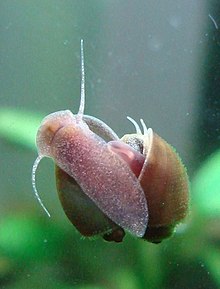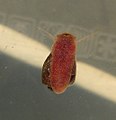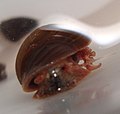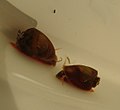Common ramshorn snail
| Common ramshorn snail | ||||||||||||
|---|---|---|---|---|---|---|---|---|---|---|---|---|

Common ramshorn snail ( Planorbella scalaris ) |
||||||||||||
| Systematics | ||||||||||||
|
||||||||||||
| Scientific name | ||||||||||||
| Planorbella scalaris | ||||||||||||
| ( Jay , 1839) |
The common ramshorn snail ( Planorbella scalaris , Syn .: Helisoma scalare ) is a water lung snail ( Basommatophora ) and belongs to the family of poppet snails ( Planorbidae ). The species was in 1839 by John Clarkson Jay as Paludina scalaris first time from the Everglades of Florida described.
features
The case is left-wound and is about 10 to 12 mm long and just under 10 mm wide. It includes three to three and a half whorls, clearly separated from each other, the last of which is significantly larger. The eponymous steps consist of the first two passages. The common English name mesa ramshorn (mesa = table mountain, table) also refers to the characteristic tip of the case, which is reminiscent of rounded steps. This is already pronounced in newly hatched animals and can be seen in embryos after about a week. The housing color varies from black to brown and reddish brown to horn-colored. Since the housing is very thin, the jacket shines through in places and some internal organs can be seen. The soft body can have a dark gray to light brown to dark red color and has numerous light speckles. The red color is caused by hemoglobin. Albinos also occur. The snails have long, straight antennae with their eyes at the base.
Habitat and Distribution
The Planorbella scalaris originally comes from the plant- rich swamps and lakes of central to southern Florida. They can now also be found in India, South Africa, South America, southern Europe and the Caribbean islands. At some sites, however, conclusive evidence is missing whether it is actually P. scalaris . Confusion with P. duryi forma seminole is possible.
Reproduction
The animals are hermaphrodites and fertilize each other. Mating can last for many hours, with the snails continuing to move. A few days after mating, they spread gelatinous clutches on plants, roots and stones, and in the aquarium accordingly also on the pane or on other furnishings. The clutches are initially colorless and change color to light brown over the course of development, but remain clear. They contain an average of around 15 to 20 eggs that are arranged in a spiral. Almost 40 eggs have also been counted in a clutch. The clutch size is determined by the size of the snail itself, but also by external factors such as the food supply. The fully developed snails hatch after one to two weeks, depending on the temperature.
Keeping in the aquarium
The Planorbella scalaris is a rather unknown and rare snail in the aquarium. It is weakly competitive and so easily by other common aquarium snails such as z. B. Planorbella duryi or Physa fontinalis displaced. It can be kept from an aquarium size of around 10 liters. The pH should be between 6.5 and 8. The water hardness can range from soft to hard, however, if necessary, care should be taken to ensure that there is a sufficient supply of calcium to avoid damage to the housing. The temperature can be between 18 and 30 ° C, but high temperatures shorten the life expectancy of the animals, which is probably around one to two years. In addition to algae, growth and dead plant parts, soft-leaved aquarium plants are also occasionally eaten. This was observed on Rotala sp ., But also on root tips of Anubias sp . Brown walnut leaves are a popular source of food, even for very small snails. Food for fish, shrimps, etc. is also gladly accepted by larger snails.
Worth knowing and special features
Occasionally individual snails seek out the surface of the water to take in air. Sometimes this creates a smacking noise. This behavior has also been observed in other aquatic snails. In some cases, they also use surface tension to crawl along below the surface of the water and eat particles from the surface. They are also able to slide through the water on slime threads. Since the shell is relatively thin and the last passage is very wide, the internal organs of the snail are quite easy to see. With great activity and also with a lack of oxygen you can see z. B. the accessory gills on the left side of the body. Sometimes parts of the genitals are also visible there. Occasionally, an air bubble can also be seen under the case.
literature
- Alexandra Behrendt: Snails for the aquarium. Gräfe Und Unzer, 2009, ISBN 978-3-8338-1521-8 ( limited preview in Google book search).
Individual evidence
- ↑ JC Jay: A Catalog of the Shells, arranged according to the Lamarckian System; together with Descriptions of New or Rare Species contained in the Collection of John C. Jay, MD 3rd Edition, Wiley & Putnam, New York, London, 1839. (digitized)
Web links
- iucnredlist.org Planorbella scalaris
- pdfs.semanticscholar.org (2011, p. 127)
- shodhganga.inflibnet.ac.in (p. 114)




